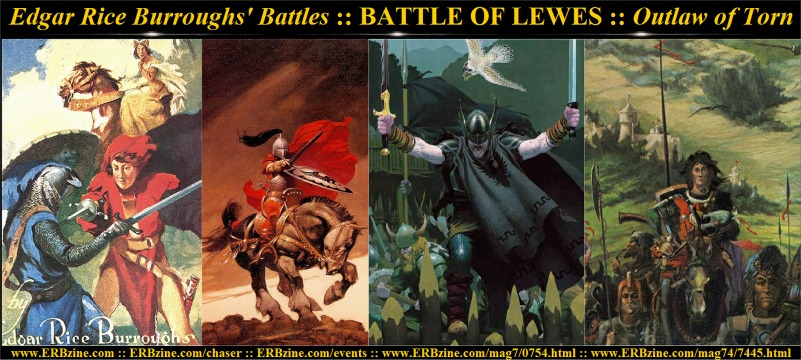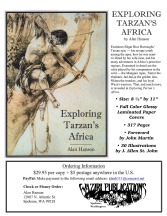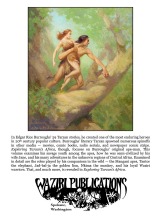Burroughs Battles:
The Battle of Lewes —
A Mixture of Fact and Fiction
by Alan Hanson
 Preface
Preface
Although Edgar Rice Burroughs occasionally
made reference to actual historical battles in his stories, the Battle
of Lewes is the only one that ERB described in detail. Of course, Burroughs’
account of the battle in The Outlaw of Torn strays in some
respects from the recorded historical accounts of the actual battle. The
description of events that follows was pieced together using the accounts
as they were recorded by both Edgar Rice Burroughs and English historians.
A
Bloody Day in May
The Battle of Lewes was fought on a
bloody Wednesday, May 14, 1264, within sight of the bell-tower of the Priory
of Lewes in East Sussex. It was fought by the forces of a majority of the
country’s barons, under the leadership of Simon de Montfort, Earl of Leicester,
attempting to retain the tenets of the Magna Carta, against King Henry
III, who was ignoring the document. As readers of Burroughs’ book know,
however, the battle was decided neither by the forces of De Montfort nor
those of Henry, but rather by the appearance of a mysterious outlaw who
had no love for either side.
De Montfort had sought to
catch the King and his 60,000 troops unaware with a pre-dawn advance through
dense forests on the ancient town where the royalist forces were encamped.
The baronial troops may have reached the city entirely undetected had not
an early morning royalist foraging party come in contact with the advancing
forces. A few escaped to rouse Henry’s sleeping army to its imminent danger.
The four divisions of De Montfort’s
army had by now come within sight of the town. On the left of the baronial
line were the Londoners, while in the center a large division had taken
position on the crest of a gently sloping hill. The right of the line was
under Henry de Montfort, the eldest son of Simon de Montfort, who kept
the baronial reserves in the rear under his personal command.
First to take the field against
them was Henry’s son, Prince Edward, who threw his forces against the Londoners.
The poorly armed and trained burghers fell like sheep before the long lances,
heavy maces and battle axes of Edward’s knights. Not content with the rout,
Edward pursued the Londoners for miles, butchering many and chasing others
to their deaths by drowning in the Ouse River.
The
Black Falcon Banner Appears
Had not Edward gone so far afield,
victory might have gone to the King’s forces early in the day, for nowhere
along the line were the baronial forces making progress toward the town.
In the center the forces were evenly matched, while on the other wing the
royalists under Prince Richard, the King’s brother, despite meeting stiff
resistance, slowly pushed Henry de Monfort’s forces up the crest of a hill.
When the King’s two reserve divisions joined their inspired comrades in
the battle, victory for the royalists seemed assured.
It was at this point that a new,
pivotal force entered the battle. Fighting on the battlefield stopped when
a great horde of knights appeared on a hill to the north of the conflict.
Even as the leader of this new force raised his hand, sending a thousand
men into a mad charge, however, the black falcon wing on the banners of
the advancing knights identified them as followers of the Outlaw of Torn,
and their cries of “For De Montfort!” and “Down with Henry!”
announced their intentions. The new force injected into the battle instantly
turned the tide. Prince Richard was captured and the King himself escaped
by the barest of chance to take refuge in Lewes.
Both the King and Simon de Montfort
later admitted that the barons owed their victory that day to Norman of
Torn alone. The irony, of course, lay in the fact that Norman, unbeknownst
to all on the field that day, including himself, was the long lost son
of King Henry. Norman had no reason to love the barons either, having warred
against them for years as he had the King’s men. What brought the Outlaw
of Torn to the field that day and placed him on the side of De Montfort
was the affection Norman felt for Bertrade, the daughter of the Earl of
Leicester.
English
leaders brought closer together
The
battle had no long-term political repercussions. In fact, within three
days Henry and De Montfort were meeting in the castle of Battel planning
to capture and hang Norman of Torn. Of course, with the revelation that
Norman was actually the little Prince Richard, who had disappeared over
20 years before, all three principals in the Battle of Lewes were reconciled.
Certainly, at least from the point of view of The Outlaw of Torn, this
was a battle that need never have been fought.
— the end —
|



![]()
 .
. .
.
![]()
![]()
![]()
![]()
![]()
![]()

![]()